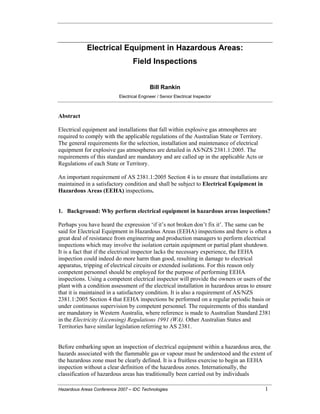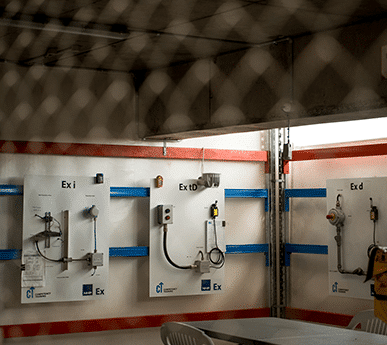Some Known Incorrect Statements About Roar Solutions
Some Known Incorrect Statements About Roar Solutions
Blog Article
The Best Strategy To Use For Roar Solutions
Table of ContentsThe smart Trick of Roar Solutions That Nobody is DiscussingThe Buzz on Roar SolutionsThe Roar Solutions Statements
In order to protect installments from a prospective explosion a method of evaluating and classifying a potentially harmful area is needed. The objective of this is to make certain the correct choice and installment of devices to inevitably avoid a surge and to guarantee safety and security of life.
(https://www.reverbnation.com/roarsolutions)
No tools ought to be mounted where the surface area temperature level of the equipment is above the ignition temperature level of the given danger. Below are some typical dirt harmful and their minimum ignition temperature. Coal Dirt 380C 225C Polythene 420C (melts) Methyl Cellulose 420C 320C Starch 460C 435C Flour 490C 340C Sugar 490C 460C Grain Dust 510C 300C Phenolic Resin 530C > 450C Aluminium 590C > 450C PVC 700C > 450C Residue 810C 570C The possibility of the risk being present in a concentration high adequate to cause an ignition will vary from place to area.
Unsafe location electrical tools possibly developed for usage in greater ambient temperatures. Field Repair By Authorised Personnel: Challenging testing may not be called for nonetheless details treatments might need to be adhered to in order for the equipment to keep its third party ranking. Each item of devices with a hazardous rating ought to be evaluated independently.
The Ultimate Guide To Roar Solutions
The tools register is a detailed database of equipment documents that includes a minimum collection of areas to determine each item's place, technical criteria, Ex lover classification, age, and ecological data. This info is critical for monitoring and managing the devices successfully within unsafe areas. In comparison, for routine or RBI sampling examinations, the grade will certainly be a combination of Thorough and Close evaluations. The ratio of Comprehensive to Shut evaluations will be figured out by the Equipment Risk, which is assessed based upon ignition threat (the chance of a source of ignition versus the probability of a flammable ambience )and the hazardous area category
( Area 0, 1, or 2). This variation will likewise affect the resourcing demands for job prep work. As soon as Great deals are defined, you can create sampling plans based on the sample dimension of each Whole lot, which refers to the number of random devices items to be evaluated. To determine the required sample dimension, 2 elements require to be evaluated: the dimension of the Whole lot and the category of assessment, which shows the degree of initiative that should be used( lowered, typical, or boosted )to the assessment of the Lot. By integrating the classification of assessment with the Lot size, you can then establish the proper denial standards for an example, indicating the permitted number of defective things found within that example. For even more details on this process, please refer to the Energy Institute Standards. The IEC 60079 conventional suggests that the optimum period in between examinations ought to not surpass three years. EEHA inspections will certainly likewise be conducted beyond RBI campaigns as part of set up upkeep and tools overhauls or repairs. These examinations can be attributed towards the RBI example sizes within the influenced Lots. EEHA inspections are performed to determine mistakes in electrical equipment. A heavy racking up system is crucial, as a solitary item of equipment might have several faults, each with differing levels of ignition threat. If the combined rating of both evaluations is much less than twice the mistake score, the Whole lot is deemed acceptable. If the Whole lot is still considered inappropriate, it needs to undergo a complete examination or validation, which may activate stricter inspection methods. Accepted Lot: The reasons for any mistakes are identified. If a typical failure mode is located, additional devices might require evaluation and repair. Faults are identified by extent( Security, Stability, Home cleaning ), guaranteeing that urgent issues are examined and resolved quickly to minimize any kind of impact on security or procedures. The EEHA data source should track and tape the lifecycle of mistakes in addition to the rehabilitative actions taken. Executing a robust Risk-Based Inspection( RBI )strategy is crucial for ensuring compliance and safety and security in taking care of Electric Devices in Hazardous Areas( EEHA) (Roar Solutions). Automated Fault Rating and Lifecycle Monitoring: Easily take care of mistakes and track their lifecycle to boost inspection precision. The intro of this assistance for risk-based assessment further strengthens Inspectivity's placement as a best-in-class solution for governing visit site conformity, in addition to for any type of asset-centric inspection use instance. If you have an interest in finding out more, we welcome you to ask for a demo and find exactly how our option can transform your EEHA monitoring processes.
An Unbiased View of Roar Solutions

In terms of eruptive risk, an unsafe area is an atmosphere in which an explosive ambience exists (or may be anticipated to be present) in quantities that require special safety measures for the building and construction, installment and use of equipment. Roar Training Solutions. In this article we discover the difficulties dealt with in the work environment, the threat control measures, and the needed proficiencies to work safely
It issues of modern-day life that we make, keep or handle a range of gases or fluids that are deemed combustible, and a series of dusts that are considered flammable. These substances can, in particular conditions, create eruptive ambiences and these can have significant and terrible consequences. Many of us recognize with the fire triangular get rid of any among the three components and the fire can not take place, yet what does this mean in the context of harmful locations? When breaking this down into its most basic terms it is basically: a combination of a particular amount of release or leak of a certain substance or material, blending with ambient oxygen, and the visibility of a resource of ignition.
In the majority of circumstances, we can do little concerning the degrees of oxygen airborne, however we can have considerable influence on sources of ignition, for example electrical equipment. Dangerous areas are documented on the hazardous area category illustration and are determined on-site by the triangular "EX-SPOUSE" indicator. Right here, amongst other key information, zones are divided into three types relying on the threat, the chance and period that an explosive environment will exist; Zone 0 or 20 is considered one of the most harmful and Zone 2 or 22 is regarded the least.
Report this page